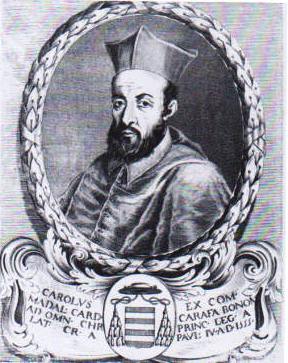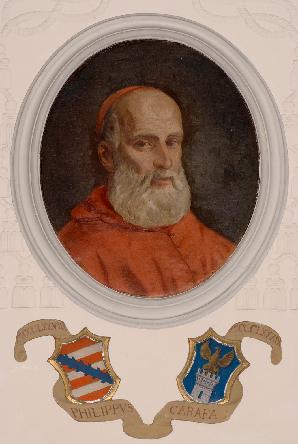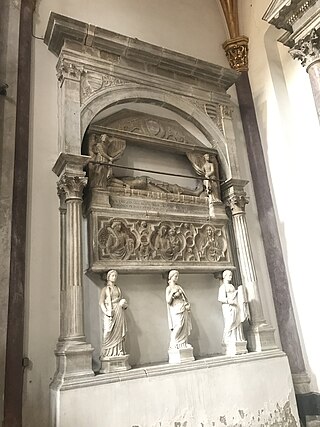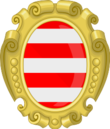
Pope Paul IV, born Gian Pietro Carafa was head of the Catholic Church and ruler of the Papal States from 23 May 1555 to his death in August 1559. While serving as papal nuncio in Spain, he developed an anti-Spanish outlook that later coloured his papacy. In response to an invasion of part of the Papal States by Spain during his papacy, he called for a French military intervention. After a defeat of the French and with Spanish troops at the edge of Rome, the Papacy and Spain reached a compromise: French and Spanish forces left the Papal States and the Pope thereafter adopted a neutral stance between France and Spain.

The dean of the College of Cardinals presides over the College of Cardinals in the Roman Catholic Church, serving as primus inter pares. The position was established in the 12th century. He always holds the rank of a cardinal bishop, and is assisted by a vice-dean. Both are elected by and from the cardinal bishops who are not Eastern Catholic patriarchs, with their election subject to papal confirmation. Except for presiding over the college, the dean and vice-dean have no power over the other cardinals. In the order of precedence in the Catholic Church, the dean and vice-dean, as the two most senior cardinals, are placed second and third, respectively, after the pope.
Giovanni Carafa may refer to:

Oliviero Carafa, in Latin Oliverius Carafa, was an Italian cardinal and diplomat of the Renaissance. Like the majority of his era's prelates, he displayed the lavish and conspicuous standard of living that was expected of a prince of the Church. In his career he set an example of conscientiousness for his contemporaries and mentored his relative, Giovanni Pietro Carafa, who became Pope Paul IV.

The Roman Catholic Suburbicarian Diocese of Ostia is an ecclesiastical territory located within the Metropolitan City of Rome in Italy. It is one of the seven suburbicarian dioceses. The incumbent Bishop is cardinal Giovanni Battista Re. Since 1150, its bishop has been the Dean of the College of Cardinals, Its Cathedral is Basilica di Sant'Aurea.

The Roman Catholic Suburbicarian Diocese of Palestrina is a Roman Catholic suburbicarian diocese centered on the comune of Palestrina in Italy.

Carlo Carafa was an Italian cardinal, and Cardinal Nephew of Pope Paul IV Carafa, whose policies he directed and whom he served as papal legate in Paris, Venice and Brussels.
Giovanni Carafa, Duke of Paliano, was a papal nephew and minor Italian prince.

Alfonso Carafa was a member of one of the oldest noble families of Naples and a cardinal of the Roman Catholic Church. His father was Antonio, Marquis of Montebello, whose uncle, Gian Pietro Carafa, ascended the papal throne in 1555 as Pope Paul IV.

Pier Luigi Carafa, Junior was an Italian cardinal from the famous Neapolitan family of Italian nobles, clergy, and men of arts. He served the papacy as Camerlengo of the Sacred College of Cardinals and as Dean of same College. He is currently buried at Sant'Andrea delle Fratte in Rome.

Pier Luigi Carafa (Senior) was a cardinal of the Catholic Church, and a member of the Roman Curia.

The 1559 papal conclave was convened on the death of Pope Paul IV and elected Pope Pius IV as his successor. Due to interference from secular rulers and the cardinals' disregard for their supposed isolation from the outside world, it was the longest conclave of the 16th century.

Girolamo Carafa, Marquis of Montenegro was a general in Spanish and Imperial service from Italian descent.

Francesco Carafa della Spina di Traetto was an Italian cardinal.

Antonio von Caraffa was a General Commissary (Generalkriegskommissär) of the Imperial-Habsburg Army—the highest rank in the Austrian military hierarchy at the time. He also held various other high-ranking offices, including military governor of Upper Hungary and later royal commissioner of Transylvania.
Diomede Carafa (1492–1560) was an Italian Roman Catholic bishop and cardinal.

The House of Pignatelli is the name an old and prominent Neapolitan family of Italian nobility, clergy, men of arts and sciences, whose members occupied significant positions in 18th and 19th century. The family has been regionally prominent since the 13th century. Among various titles, they held the title of Prince of the Holy Roman Empire.

The House of Acquaviva is an aristocratic Italian family from Naples. The head of the family was Duke of Atri in the Abruzzo from the 15th century, and Count of Conversano after an Orsini family marriage in 1546, among other titles.

Filippo Carafa della Serra was an Italian Cardinal of the Roman Catholic Church.

Antonio Carafa, called Malizia, was a nobleman and diplomat of the Kingdom of Naples. In the conflict between the Durazzo and Valois over the throne, he supported the Durazzo. He played a major role in the creation of the Aragonese claim to the throne and was a staunch supporter of King Alfonso V of Aragon until his death.
















